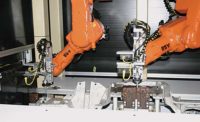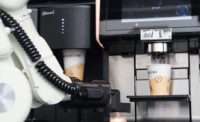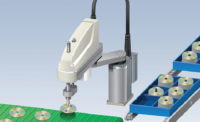Like people, robots need to be placed in jobs that best suit their capabilities. Some robots, for example, are more productive when they work alone or in tandem to complete an assembly process. Others are specifically designed to work alongside humans on the assembly line.
However, each robot requires the right end-effector—also called end-of-arm tooling (EOAT)—to properly perform a specific task. An end-effector is any object that attaches to the robot’s flange (wrist). End-effectors include grippers, suction cups, clamps, tool changers, collision sensors, rotary joints, press tooling, compliance devices, deburring tools, dispense valves, arc welding guns, and many other types of tooling.
End-effector selection depends not on the number of robots, but on application factors such as part type, production level and available work space. For example, a small suction cup is ideal for a pick-and-place robot assembling electronics and consumer products—whereas multiaxis robots require specially designed grippers to safely load and unload sheet metal panels from a stamping workcell in an automotive plant.
Human-like robots, such as those competing in the DARPA Robotics Challenge Finals next June, also require specialty end-effectors. One such robot, THOR (made by Virginia Tech University), is equipped with force-torque sensors from ATI Industrial Automation.
To enhance human-robot collaboration, suppliers like Robotiq offer
electric grippers with self-adaptive fingers that can pick up a wide variety of parts. One collaborative robot, the PRob made by F & P Personal Robotics, even features a built-in two-finger gripper.
“End-effectors have come of age the last 25 years or so,” says Bob Little, president and CEO of ATI Industrial Automation. “Back then the industry was just a baby. Today, they are, in essence, young adults, and very capable of optimizing robot productivity in every industry.”
Expectation Evolution
When robots began appearing in factories in the 1960s and 1970s, their EOAT was made by robot companies or integrators. Specialty end-effector suppliers didn’t come into being until the early 1980s.
“The early tooling was large, bulky and didn’t work very well,” recalls Little, who co-founded ATI Industrial Automation in 1989. The company specializes in tool changers. “Hydraulic grippers were too powerful and crushed some of the parts they grabbed. Other grippers relied on springs to open or close their jaws, but usually performed poorly.”
SCHUNK introduced its first family of rotary and linear pneumatic grippers, encompassing six sizes, in 1982. Jesse Hayes, automation group manager for the company, says the grippers featured an adapter plate that mounted to several models of robots, eliminating the need for a manufacturer to buy or build custom EOAT for each robot. He says that increasing robot flexibility remains the main purpose of EOAT.
Robots are more reliable than ever, and, in general, are not the cause of downtime, according to Hayes. This is why many manufacturers are willing to pay upfront for good EOAT, and make sure that it doesn’t become the weak link in the production line.
“Over the past 10 years, as robots have increased their control, speed and precision, customers have come to expect the same from their EOAT,” says Cale Reese, product development manager for PHD Inc. “This applies to gripping and clamping applications ranging from moving 2,000-pound engine blocks between machine centers, to handling few-ounce lids for contact-lens cases.”
Mike Guelker, product manager for actuators and air supply for Festo Corp., says that manufacturers are increasingly using electric grippers because they offer greater force, stroke and control than pneumatic. However, comparable-size pneumatic grippers provide much higher gripping forces and are much lighter. Manufacturers also are integrating their grippers with vision systems for high-speed applications and those involving odd-shaped and multiple parts.
“We’ve been developing electric grippers to replace pneumatic ones for the past 15 years,” says Hayes. “But, it’s very hard to get equal power density when substituting an electric motor for a pneumatic cylinder. For example, if the pneumatic gripper weighs 5 pounds, the equivalent electric gripper, in force and stroke, needs to be two to three times heavier and larger. Compressing air is getting more expensive, but there are other factors besides cost that need to be addressed.”
Consider a situation where the manufacturer operates a 15-kilogram-payload robot with a pneumatic EOAT that’s already close to the payload limit. By switching to an electric EOAT, there’s a good chance the company will surpass the payload limit and need to replace the current robot with a larger, more expensive one.
Hayes notes, however, that this problem only applies to the replacement of small pneumatic grippers. He says the larger the pneumatic gripper, the easier it is to justify switching to electric.
What’s in a Name?
There are four types of EOAT. The impactive type refers to grippers or tooling with claws or fingers that physically grasp a part through direct impact. Astrictive tooling applies suction force to the part using vacuum cups, or magneto or electroadhesion.
Ingressive tooling physically penetrates the object surface. It includes pins, needles and hackles, and is often used in textile, carbon and glass-fiber handling. Contigutive tooling relies on direct adhesion (surface tension, glue or freezing) to grasp a part.
Despite these categories, manufacturers frequently interchange terms. For example, Little says current and prospective customers often refer to tool changers as “connectors” and EOAT as “robotic accessories” or “end-of-arm devices.”
“For many European manufacturers, the term ‘gripper’ refers to all EOAT on a robot,” notes Rob Pitera, global product director for end effectors for DE-STA-CO. “What our company calls ‘gripper fingers’—which are used to lift sheets of material—someone else might call a ‘spider gripper.’ I try to accommodate their language, while also clarifying terms so we’re both on the same page.”
Pneumatic grippers and vacuum cups remain the most common type of EOAT, along with tool changers. Usually, the gripper’s body is made of standard aluminum, to limit weight and cost, and the gripper’s jaws are made of hardened steel, to withstand wear from constant opening and closing.
However, some suppliers now offer gripper bodies made of aircraft-quality or plated aluminum, carbon fiber, PET plastic or layered plywood. Pitera says carbon fiber is lighter than aluminum and can be made stronger than steel. Guelker says the PET plastic body is great for clean rooms and corrosion-resistant areas within medical-device, electronics and semiconductor plants.
The fingers that attach to the jaws may be made of various materials, depending on the application. Hayes says customers have used fingers made of aluminum, steel, ceramic, glass-reinforced polymers, brass or bronze.
Vacuum cups come in all sizes, shapes, durometers and materials, including fluoroelastomer, nitrile rubber, silicone and polyurethane. To better grab contoured parts, some manufacturers prefer vacuum foam pads over cups.
Among the newer types of EOAT, force-torque sensors are becoming increasingly popular because they increase the tooling’s “touch” capability. Little cites one large automaker that, for five years, has used a sensor-equipped ABB robot to carefully locate, lift and insert a 45-pound camshaft into a dark housing using only a sense of touch. Prior to this, workers were only able to work 1-hour shifts due to the heavy lifting.
Standard Innovation
As manufacturers increasingly produce smaller products with greater capabilities, gripper suppliers have responded in kind. SCHUNK, for example, offers the EGP two-finger electric parallel gripper for small assembly processes. This gripper is used often by syringe and catheter manufacturers, and by those in the life sciences to handle micro plates. Three sizes are available, with a grip force up to 140 newtons and a stroke range of 3 to 6 millimeters per finger.
ATI’s QC-001 micro robotic tool changer enables high-speed, parallel-link (spider) robots to perform multiple assembly, dispensing, sorting, and material-handling operations with quick changeovers. The tool changer works with robots that handle payloads of less than 3 pounds, although higher payloads are possible with a lower moment rating. It is compact (1.8 inches in diameter) and lightweight (0.21 pound).
This past summer the company introduced the L1 and P1 compliance devices for EOAT. Both devices allow pieces to be gripped or routed reliably, even if they are severely misaligned. The L1 allows for X-Y lateral compliance of ±2.6 millimeters and Z rotational compliance of ±18 degrees. Little says the P1 is for bin-picking, automated assembly and robotic finishing applications, and it offers rotation compliance of 13 degrees in all three directions with no lateral movement.
IPR Robotics Inc., which specializes in custom EOAT, recently developed the NGF pneumatic gripper for handling soft materials. Dan Peretz, vice president for North America at IPR Robotics Inc., says up to 12 such grippers can be used together to handle material sheets up to 15 feet wide.
Only two air ports are needed to operate the 12 grippers, which feature steel fingers with needles that pierce material. To ensure material cleanliness, the needles are automatically wiped after each use. The gripper also features an aircraft-aluminum body.
Among IPR’s other custom tooling is the KA alignment device with on-center and off-center locking capability. Integrator Creative Automation Inc. uses the device to help a robot find, lift and place power distribution modules (PDMs) into electric motors. After a gripper closes on a PDM, the robot lifts it from a pallet and locks the device into a centered position, enabling easy seating of the PDM into the motor.
To help manufacturers reduce their pneumatic-tooling air consumption, DE-STA-CO offers the auto-release Venturi vacuum generator with a single air line. Pitera says the generator produces vacuum levels up to -0.88 bar with an air line pressure of 4 bar. Air consumption is 40 liters per minute during vacuum and zero during blowoff. Speed to vacuum is 0.2 to 0.3 second, and speed to blowoff is 0.2 second.
Festo developed its new MultiChoiceGripper in close collaboration with the University of Linz in Austria. The pneumatic gripper features Fin Ray fingers that easily handle differently shaped and sensitive objects without additional sensor or control technology.
Guelker says computer and television manufacturers use Festo’s light-contact OGGB grippers to transport glass screens and PCBs. The grippers function according to the Bernoulli principle: incoming compressed air is deflected radially in the gripper, greatly accelerated, and flowed back out, thereby generating a vacuum between the gripper and workpiece.
Because of this, the grippers minimize workpiece contact and are ideally suited for thin, delicate and brittle workpieces. “A handful of these grippers can lift a much-heavier product without leaving any marks,” says Guelker.
Earlier this year, PHD introduced its Model 86560 series of pneumatic magnetic grippers that lift and move ferromagnetic pieces, such as steel sheets, blanks and stamped parts. They are available with a 25-millimeter bore and a pull strength of 0.5, 2.5, 4.5 or 11 pounds. A polymer shock pad and stainless steel head prevent impact damage.
Knowing the benefits of additive manufacturing, RÖHM GmbH uses selective laser sintering to make its synthetic RRMP gripper. Matthew Mayer, CEO of RÖHM Products of America Inc., says the gripper’s jaws feature a free-form surface that adapts to individual workpieces. Extremely lightweight, the gripper is ideal for complex, sensitive parts. External and internal gripping are possible.
“Wherever robots go, EOAT must go,” concludes Little. “Whether that’s the assembly line, the operating room or the next craft that roves over Mars.”







